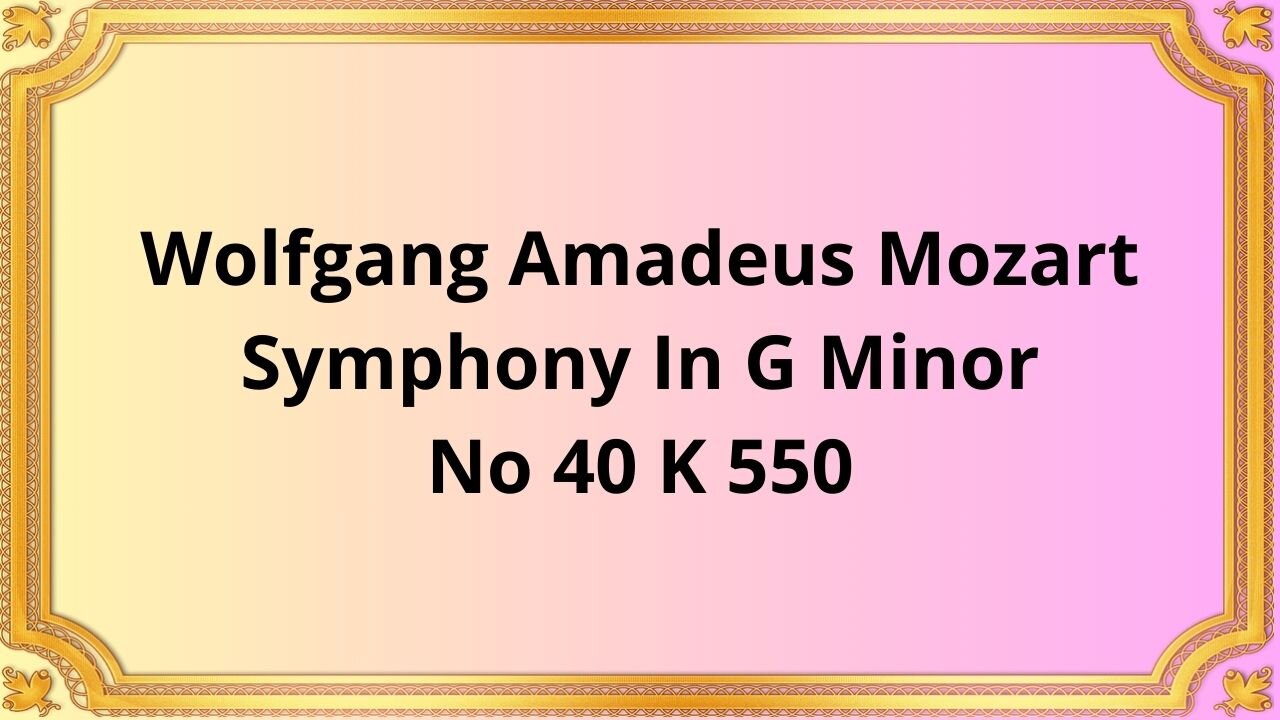Premium Only Content

Wolfgang Amadeus Mozart Symphony In G Minor, No 40 K 550 (1951)
#Mozart #ClassicalMusic #SymphonyInGMinor #MusicComposition #MozartSymphonyNo40 #MusicHistory #ClassicalComposers #18thCenturyMusic #OrchestralMusic #ClassicalSymphonies #MozartAnalysis #MusicAppreciation #GMinorSymphony #MozartLegacy #MozartInfluence #MusicGenius
Publication date 1951
2 Oboes : 2 Horns : 2 Bassoons
KARL MAYERHOFER Oboe
BRUNO DOERRSCHMIDT Oboe
GOTTFRIED von FREIBERG Horn
LEOPOLD KAIN Horn
KARL OEHLBERGER Bassoon
RUDOLPH HANSLL Bassoon
Wolfgang Amadeus Mozart's Symphony in G Minor, No. 40 K 550 is an iconic composition that showcases the genius of Mozart and represents a pinnacle of classical music. Written during the classical period, this symphony is a testament to Mozart's exceptional talent and his ability to create emotionally captivating and technically brilliant works.
Composed in 1788, Mozart's Symphony in G Minor, No. 40 K 550 was one of the three symphonies he wrote during a prolific summer. This period was marked by financial difficulties for Mozart, yet he managed to create some of his most profound and complex works. Despite its initial reception being relatively modest, this symphony has since become one of Mozart's most beloved and frequently performed compositions.
Symphony No. 40 follows the traditional four-movement structure of a classical symphony. The first movement, marked Molto allegro, begins with a dramatic and instantly recognizable theme played by the strings. This movement is characterized by its relentless energy, driving rhythms, and emotional intensity.
The second movement, marked Andante, provides a stark contrast to the first. It features a lyrical and melancholic melody, beautifully expressed through the strings. The serene and introspective nature of this movement allows for a moment of reflection amidst the overall intensity of the symphony.
The third movement, marked Menuetto: Allegretto, is a lively and elegant minuet. It showcases Mozart's mastery of form and his ability to create memorable melodies. The contrasting trio section provides a brief respite before returning to the energetic main theme.
The final movement, marked Allegro assai, is a tour de force of virtuosity and excitement. It opens with a spirited theme that permeates throughout the movement, showcasing Mozart's brilliant orchestration and his ability to build tension and release it with moments of sheer exhilaration.
Mozart's Symphony No. 40 is renowned for its rich harmonic language, exquisite melodies, and masterful orchestration. The symphony is characterized by its dramatic and emotional nature, with contrasting moments of light and darkness. Mozart's use of dynamic contrasts, intricate counterpoint, and seamless transitions between sections contribute to the overall impact of the music.
Furthermore, the symphony exemplifies Mozart's ability to create memorable themes that resonate with listeners. The opening theme in the first movement, for example, establishes a sense of urgency and sets the tone for the entire piece. Additionally, the use of recurring motifs and melodic development throughout the symphony adds depth and coherence to the composition.
Wolfgang Amadeus Mozart Symphony in G Minor, No. 40 K 550 is a remarkable musical composition that continues to captivate audiences centuries after its creation. Its emotional depth, technical brilliance, and timeless beauty make it a true masterpiece of classical music. Mozart's ability to convey a range of emotions within a well-structured and expertly orchestrated symphony showcases his unparalleled genius. Symphony No. 40 serves as a testament to Mozart's enduring legacy and his significant contributions to the world of classical music.
You have the opportunity to support the channel:
https://destream.net/live/RadSiarAl/donate
https://www.buymeacoffee.com/6355radsiaral
-
 33:15
33:15
Classical music_Music Inspiration
1 month agoPyotr Ilyich Tchaikovsky Piano Concerto No. 1 in B-flat minor, Op. 23
501 -
 DVR
DVR
Man in America
7 hours agoThe Shocking Reason Your ‘Healthy’ Diet Is Making You Sick w/ Kim Bright
11K1 -
 LIVE
LIVE
SpartakusLIVE
5 hours agoThe Spartan and The Dragon take on the EASTER EGG Tower || Duos w/ Rallied
159 watching -
 LIVE
LIVE
Spartan
5 hours agoPro Halo Player
149 watching -
 8:59
8:59
MattMorseTV
7 hours ago $0.85 earnedMexico's President just made a BIG MISTAKE.
41K42 -
 LIVE
LIVE
VapinGamers
2 hours ago $0.01 earned🔫 Splitgate 2 - Electric Boogaloo with ThisIsRayGaming - !rumbot Beta Test New Version
91 watching -
 1:32:56
1:32:56
Glenn Greenwald
6 hours agoPalantir EXPOSED: Spying on Americans & Expanding the Privatized Deep State | SYSTEM UPDATE #465
122K74 -
 1:53:49
1:53:49
RiftTV/Slightly Offensive
6 hours ago“BRING IN THE TROOPS”: Trump Orders Riot to be SHUT DOWN | The Rift | Guest: Anthony Cabassa
45.4K28 -
 LIVE
LIVE
We Like Shooting
15 hours ago $0.05 earnedWe Like Shooting 614 (Gun Podcast)
183 watching -
 2:06:03
2:06:03
PudgeTV
4 hours ago🔵 Mod Mondays Ep 66 | The Italian CEO on Rumble | Business, Pizza & Streaming
19.6K4